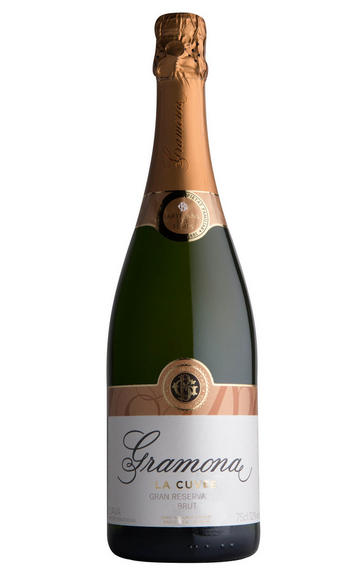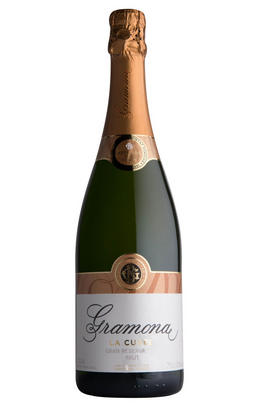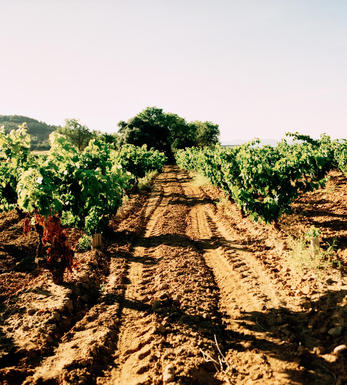
2009 Cava Gramona, Argent, Gran Reserva, Brut, Catalonia, Spain

Critics reviews
About this WINE

Bodegas Gramona
Gramona are acknowledged, in Spain and beyond, to be the the finest of all Cava Houses (voted among the Top of 100 Wineries of 2010 in the Wines & Spirits magazine).
Fine Cava, I hear you say, is that not something of an oxymoron? Can they really make fine sparkling wine in Catalonia, when the Champenois have for centuries insisted that the climatic conditions at 49 degrees of latitude are essential for that gentle pirouette of tension between acidity, sugar and fruit which is necessary for the creation of the very finest of sparkling wines.
In addition, Cava, from the seventies onwards, has grown on an industrial scale, neglecting, in the quest for volume, those finer artisanal features which underwrite all of the world’s best wines. Gramona is an extremely honourable exception to this flight from quality and Jaume and Xavier Gramona, from the fifth generation of a family which was created in 1881, are extraordinarily competent winemakers and very fine ambassadors.
Ambassadors who are both trained in oenology and passionate about their wines and about redefining the reputation of the Cava category. To this end, they take advantage of the best Penèdes locations, specifically La Plana and the steep slopes of Mas Escorpi, and an approach to winemaking which centres on extensive ageing and low levels of sugar.
Indeed the wines are aged in the Champagne method, that is to say in bottle on the yeast that has allowed the second fermentation and for a period of between 18 months and ten years. Only the very best Vintage Champagnes benefit form this kind of regime, and it should be no surprise, therefore, that the Gramona wines can take on qualities more usually associated with the most regal of their Champenois cousins.
For those who associate Cava with earthy, almost rubbery flavours, the legacy of mass-market mediocrity, this will come as something of a surprise. Instead the wines are astonishingly complex and take on nutty biscuity and autolytic notes, with exceptional balancing acidity and low levels of added sugar in the name of structural harmony.
The Gramonas have not achieved this by evading their heritage; on the contrary, it is an alchemical manipulation of the historical grapes (Macabeo, Xarel-lo and Parellada) added to a little Chardonnay, that has forged a distinctive style. These are great wines and a source of as well as for great celebration as they broaden the quality sparkling wine category, fuelling it with interest and diversity

Cava
Parellada, Macabeo and Xarel-lo are the dominant grapes used in the production of the Spanish sparkling wine Cava. Other grapes that are allowed in the blend are Chardonnay, Pinot Noir, Garnacha, Monastrell and Subirat (loosely related to Malvasia). Single varietal cavas tend to be made by 100% Macabeo (which is also the preferred grape for Cava, typically forming at least 50% in multi-varietal blends).
Cava can be white or rosé, the latter is produced by adding in still red wine sourced from Pinot Noir, Garnacha, Monastrell or Trepat into the fermented sparkling wine prior to bottling.
Over 95% of Cava production originates from in the Penedès area in Catalonia. Aside this, a further eight different regions throughout Spain are also producing small quantities of Cava. The village of Sant Sadurní d'Anoia is home to many of Spain's largest production houses , led by Codorniu and Freixenet.
Bodegas Gramona are acknowledged, in Spain and beyond, to be the the finest of all Cava Houses (it has recently been voted among the Top of 100 Wineries of 2010 in the Wines & Spirits Magazine. The essence of their winemaking approach centres on extensive ageing and low levels of sugar, just like many finest Champagnes.
Only wines produced in the traditional method (méthode champenoise) are awarded the DO (Denomination Origin) Cava, those produced by other processes such as tank fermentation, may only be labelled vinos espumosos (sparkling wines).

Chardonnay
Chardonnay is often seen as the king of white wine grapes and one of the most widely planted in the world It is suited to a wide variety of soils, though it excels in soils with a high limestone content as found in Champagne, Chablis, and the Côte D`Or.
Burgundy is Chardonnay's spiritual home and the best White Burgundies are dry, rich, honeyed wines with marvellous poise, elegance and balance. They are unquestionably the finest dry white wines in the world. Chardonnay plays a crucial role in the Champagne blend, providing structure and finesse, and is the sole grape in Blanc de Blancs.
It is quantitatively important in California and Australia, is widely planted in Chile and South Africa, and is the second most widely planted grape in New Zealand. In warm climates Chardonnay has a tendency to develop very high sugar levels during the final stages of ripening and this can occur at the expense of acidity. Late picking is a common problem and can result in blowsy and flabby wines that lack structure and definition.
Recently in the New World, we have seen a move towards more elegant, better- balanced and less oak-driven Chardonnays, and this is to be welcomed.


Buying options
Add to wishlist
Description
Gramona is acknowledged, in Spain and beyond, to be the finest of all Cava Houses. Fine Cava, I hear you say, is that not something of an oxymoron? Gramona is an extremely honourable exception to Cava’s flight from quality. The wines are astonishingly complex and take on nutty biscuity and autolytic notes, with exceptional balancing acidity and low levels of added sugar in the name of structural harmony.
Unusually made from 100 percent Chardonnay, this is about as far as it is possible to be from supermarket Cava; lazy mediocrity has ceded to power and glorious harmony. The nose of vanilla, large stone fruit and praline coaxes to a palate which is ripe, rich and unnervingly long.
The Argent is Gramona’s rebellious cuvée, decked in modish, minimalist livery and made up of 100 percent Chardonnay. Comparisons with blanc de blancs Champagne are instructive and generally favourable; the Argent really showing its worth with its distinctive almost tropical fruit and the fine weave of its mousse. Hints of toast and vanillin complete the seduction.
Simon Field MW - Wine Buyer
wine at a glance
Delivery and quality guarantee